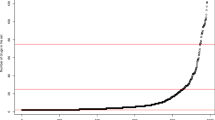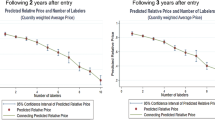Abstract
We study price competition between high-quality global products and low-quality local products in a developing country, i.e., China, Nearly all previous studies on pharmaceutical price competition focused on developed countries with bioequivalent generics. In China, local generic products are not bioequivalent and are deemed of lower quality, while global products in the same class are considered similar in quality and better substitutes. We hypothesize that local generic competition drives down local product price but not global product price. In addition, we hypothesize that therapeutic competition among similar global products lowers global product price. Our empirical results support both hypotheses. Number of local generic competitors has a significantly negative effect on local product price but no effect on global product price, while number of global therapeutic competitors has a significantly negative effect on global product price. Policy changes that encourage bioequivalent local products and accelerate global product approvals will enhance price competition in China.
Similar content being viewed by others
References
Caves, Richard E., Michael D. Whinston and Mark A. Hurwitz. (1991). Patent Expiration, Entry, and Competition in the U.S. Pharmaceutical Industry. Brookings Papers on Economic Activity: Microeconomics 1991, 1–66.
Danzon, Patricia M. and Li-wei Chao. (2000). “Does Regulation Drive out Competition in Pharmaceutical Markets?” Journal of Law and Economics XLIII, 311–357.
Danzon, Patricia M., Y. Richard Wang and Liang Wang. (2003). “The Impact of Price Regulation on the Launch Delay of New Drugs: Evidence from Twenty-Five Major Markets in the 1990s.” NBER Working Paper No. w9874, July 2003. Available at http://www.nber.org.
Frank, Richard G. and David S. Salkever. (1997). “Generic Entry and the Pricing of Pharmaceuticals.” Journal of Economics and Management Strategy 6(1), 75–90.
Grabowski, Henry G. and John M. Vernon. (1992). “Brand Loyalty, Entry, and Price Competition in Pharmaceuticals After the 1984 drug act.” Journal of Law and Economics XXXV, 331–350.
IMS Health. (2004). IMS Market Prognosis, Asia 2004-2008. May 2004, London, UK.
Kremer, Michael. (2002). “Pharmaceuticals and the Developing World.” Journal of Economic Perspectives 16(4), 67–90.
Wang, Y. Richard, Lei Ji, and Y. Aileen Lin. (2003). “Intellectual Property Right Protection for Pharmaceuticals in Developing Countries: A Case Study of Administrative Protection in China.” Pharmaceutical Development and Regulation 1(4), 277–282.
Author information
Authors and Affiliations
Corresponding author
Additional information
JEL Code I11, L11
Disclosure: This project was funded by AstraZeneca Pharmaceuticals. The views expressed in this article do not represent those of AstraZeneca Pharmaceuticals.
Rights and permissions
About this article
Cite this article
Wang, Y.R. Price competition in the chinese pharmaceutical market. Int J Health Care Finance Econ 6, 119–129 (2006). https://doi.org/10.1007/s10754-006-5558-5
Issue Date:
DOI: https://doi.org/10.1007/s10754-006-5558-5




